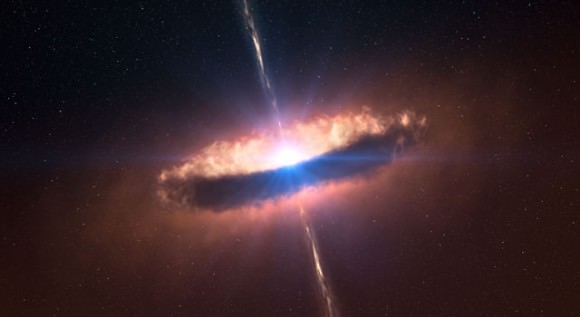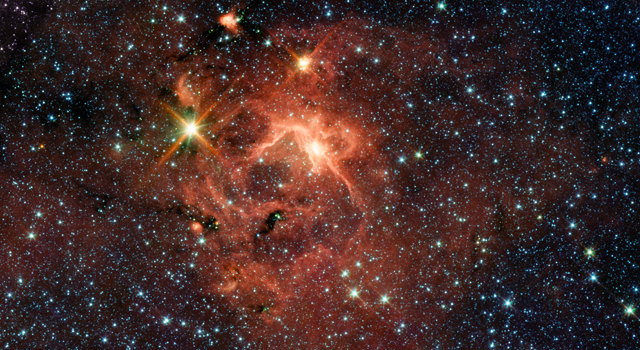[/caption]
How do massive stars form? This has been one of the more hotly debated questions in astronomy. Do big stars form by accretion like low-mass stars or do they form through the merging of low mass protostars? Since massive stars tend to be quite far away and usually are surrounded by a shroud of dust, they are difficult to observe, said Stefan Kraus from the University of Michigan. But Kraus and his team have obtained the first image of a dusty disc closely encircling a massive baby star, providing direct evidence that, big or small, all stars form the same way.
“Our observations show a disc surrounding an embryonic young, massive star, which is now fully formed,” said Kraus. “It’s the first time something like this has been observed, and the disk very much resembles what we see around young stars that are much smaller, except everything is scaled up and more massive.”
Not only that, but Kraus and his team found hints at a potential planet-forming region around the nascent star.
Using ESO’s Very Large Telescope Interferometer Kraus and his team focused on IRAS 13481-6124, a star located about 10,000 light-years away in the constellation Centaurus, and about 20 times more massive than our sun. “We were able to get a very sharp view into the innermost regions around this star by combining the light of separate telescopes,” Kraus said, “basically mimicking the resolving power of a telescope with an incredible 85-meter (280-foot) mirror.”
Kraus added that the resulting resolution is about 2.4 milliarcseconds, which is equivalent to picking out the head of a screw on the International Space Station from Earth, or more than ten times the resolution possible with current visible-light telescopes in space.
They also made complementary observations with the 3.58-meter New Technology Telescope at La Silla. The team chose this region by looking at archived images from the Spitzer Space Telescope as well as from observations done with the APEX 12-meter submillimeter telescope, where they discovered the presence of a jet.
“Such jets are commonly observed around young low-mass stars and generally indicate the presence of a disc,” says Kraus.

From their observations, the team believes the system is about 60,000 years old, and that the star has reached its final mass. Because of the intense light of the star — 30,000 times more luminous than our Sun — the disc will soon start to evaporate. The disc extends to about 130 times the Earth–Sun distance — or 130 astronomical units (AU) — and has a mass similar to that of the star, roughly twenty times the Sun. In addition, the inner parts of the disc are shown to be devoid of dust, which could mean that planets are forming around the star.
“In the future, we might be able to see gaps in this and other dust disks created by orbiting planets, although it is unlikely that such bodies could survive for long,” Kraus said. “A planet around such a massive star would be destroyed by the strong stellar winds and intense radiation as soon as the protective disk material is gone, which leaves little chance for the development of solar systems like our own.”
Kraus looks forward to observations with the Atacama Large Millimeter/submillimeter Array (ALMA), currently under construction in Chile, which may be able to resolve the disks to an even sharper resolution.
Previously, Spitzer detected dusty disks of planetary debris around more mature massive stars, which supports the idea that planets may form even in these extreme environments. (Read about that research here.) .


Good news all around!
First that solar system/planetary system formation is easier to understand than some scenarios would lead to. Second that exoplanets may be more plentiful. (I’m not as worried by the prospect of high mass stars blowing formed planets away until it’s shown to happen.)
Also, the 1:1 mass ratio of the star/protoplanetary disk seems a familiar datum.
Shouldn’t this statement, “They also made complimentary observations with the 3.58-meter New Technology” be changed to read, “They also made complementary observations with the 3.58-meter New Technology” ?
I realize this is being nit-picky, but the meanings of what is being said is definitely changed by the word used. An excellent article, either way, either meaning!
@ Conshana,
You are correct; complement(ary) and compliment(ary) are often confused because of their identical pronunciations: the former has the sense of completion; the latter has the sense of praising.
@ Conshana, and IVAN — noted. Changed. Thanks.
Oh, er… I almost forgot… the research paper:
A hot compact dust disk around a massive young
stellar object (PDF).
IVAN… you’re creating monsters! 🙂
Accretion everywhere in the universe. Anything that wants to grow accretes. Well, I guess this is also true for human beings somehow ;). Nonetheless, it’s time to understand the process; I should hurry, or someone else will crack it. 😉
Yes, I have dreams and aims! Is that forbidden? Hm… my coat is hanging there, maybe not for so long anymore… CU! 😉